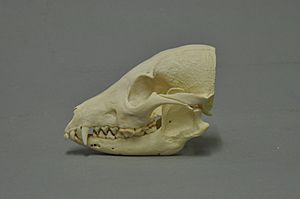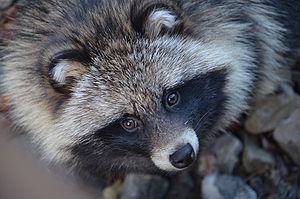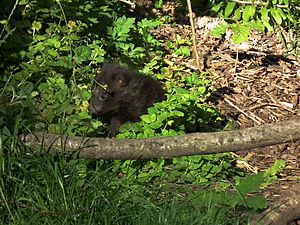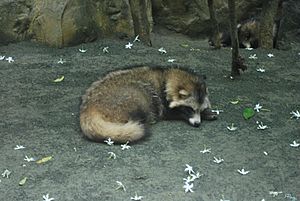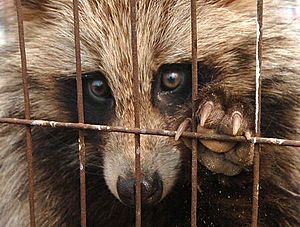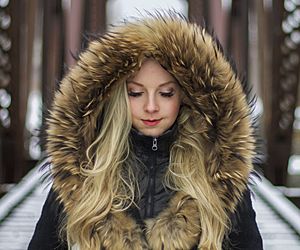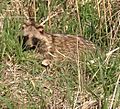Raccoon dog facts for kids
Quick facts for kids Raccoon dog |
|
|---|---|
 |
|
| N. procyonoides in Shiraishijima, Japan. | |
| Conservation status | |
| Scientific classification | |
| Genus: |
Nyctereutes
|
| Species: |
procyonoides
|
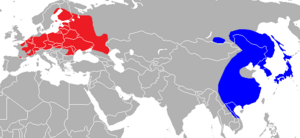 |
|
| Raccoon dog range Blue – native area Red – area of introduction |
|
The raccoon dog, also known as the mangut (its Evenki name), tanuki or neoguri, is a canid indigenous to East Asia. It is the only extant species in the genus Nyctereutes. Despite its name, its closest relatives are true foxes and not the American raccoons.
Among the Canidae, the raccoon dog shares the habit of regularly climbing trees only with the North American gray fox, another basal species.
The raccoon dog is named for the resemblance of its masked face to that of the raccoon (Procyon lotor), a procyonid to which it is not closely related. In Japan, it is known as the tanuki and has a long history in folklore. In Sweden, where it is called mårdhund ("marten-dog"), and in Denmark, where it's called mårhund (same meaning), it has been treated as a potentially hazardous invasive species..
Contents
Description
Raccoon dog skulls greatly resemble those of South American foxes, particularly crab-eating foxes, though genetic studies reveal they are not closely related. Their skulls are small, but sturdily built and moderately elongated, with narrow zygomatic arches. The projections of the skull are well-developed, the sagittal crest being particularly prominent in old animals.
Reflecting their omnivorous diets, raccoon dogs have small and weak canines and carnassials, flat molars, and relatively long intestines – (1.5–2.0 times longer than other canids). They have long torsos and short legs. Total lengths can range from 45 to 71 cm (18 to 28 in). The tail, at 12 to 18 cm (4.7 to 7.1 in) long, is short, amounting to less than a third of the animal's total length and hangs below the tarsal joints without touching the ground. The ears are short and protrude only slightly from the fur.
Weights fluctuate according to season: in March they weigh 3 kg (6.6 lb), while in August to early September males average 6.5–7 kg (14–15 lb), with some individuals attaining a maximal weight of 9–10 kg (20–22 lb). Specimens from Japanese and Russian studies have been shown to be on average larger than those from Chinese studies.
The winter fur is long and thick with dense underfur and coarse guard hairs measuring 120 mm in length. The winter fur protects raccoon dogs from low temperatures ranging down to −20° to −25°C. It is of a dirty, earth-brown, or brownish-grey colour with black guard hairs. The tail is darker than the torso. A dark stripe is present on the back, which broadens on the shoulders, forming a cross shape. The abdomen is yellowish-brown, while the chest is dark brown or blackish. The muzzle is covered in short hair, which increases in length and quantity behind the eyes. The cheeks are coated with long, whiskery hairs. The summer fur is brighter and reddish straw-coloured.
A rare, white color phase occurs in this species in Japan and in China.
Raccoon dogs exhibit a number of traits shared in common with other small carnivores which may be basal. Fur colouring, in particular the facial mask, bears some similarity to raccoons and a number of civets. Behavior also: Raccoon dogs are nocturnal, yet adjust their daily schedule and habits in response to local availability of food, similar to viverrids, ferrets, weasels, raccoons, and red pandas, to which raccoon dogs are not closely related.
Ecology
Diet
Raccoon dogs are omnivores that feed on insects, rodents, amphibians, birds, fish, reptiles, mollusks, carrion, and insectivores, as well as fruits, nuts, and berries. Among the rodents targeted by raccoon dogs, voles seem to predominate in swampy areas, but are replaced with gerbils in flatland areas such as Astrakhan. Frogs are the most commonly taken amphibians; in the Voronezh region, they frequently eat fire-bellied toads, while European spadefoot toads are usually taken in Ukraine. Raccoon dogs are able to eat toads that have toxic skin secretions by producing copious amounts of saliva to dilute the toxins. They prey on waterfowl, passerines, and migrating birds. Grouse are commonly hunted in their introduced range, and many instances of pheasant predation are recorded in the Ussuri territory.
Raccoon dogs eat beached fish and fish trapped in small water bodies. They rarely catch fish during the spawning season, but eat many during the spring thaw. In their southern range, they eat young tortoises and their eggs. Insectivorous mammals hunted by raccoon dogs include shrews and hedgehogs, and on rare occasions, moles and desmans. In the Ussuri territory, large moles are their primary source of food. Plant food is highly variable, and includes bulbs, rhizomes, oats, millets, maize, nuts, fruits, berries, grapes, melons, watermelons, pumpkins, and tomatoes. In Japan, they have been observed to climb trees to forage for fruits and berries, using their curved claws to climb.
Raccoon dogs adapt their diets to the season; in late autumn and winter, they feed mostly on rodents, carrion, and feces, while fruit, insects, and amphibians predominate in spring. In summer, they eat fewer rodents, and mainly target nesting birds and fruits, grains, and vegetables.
Predators
Wolves are the main predators of raccoon dogs, killing large numbers of them in spring and summer, though attacks have been reported in autumn, too. In Tatarstan, wolf predation can account for 55.6% of raccoon dog deaths, while in northwestern Russia, it amounts to 64%. Red foxes kill raccoon dog pups, and have been known to bite adults to death.
Both foxes and Eurasian badgers compete with raccoon dogs for food, and have been known to kill them if raccoon dogs enter their burrows. Eurasian lynxes rarely attack them. Birds of prey known to take raccoon dogs include golden eagles, white-tailed eagles, goshawks, and eagle owls.
Behavior
Reproduction and development
The mating season begins from early February to late April, depending on location. Raccoon dogs are monogamous animals, with pair formations usually occurring in autumn.
The gestation period lasts 61–70 days, with pups being born in April–May. Litter sizes typically consist of 6–8 pups, though 15–16 pups can be born in exceptional cases. First-time mothers typically give birth to fewer pups than older ones. Males take an active role in raising the pups. This male role is very significant, as demonstrated by early releases in 1928 of pregnant females without males, resulting in very limited success at introduction, while later releases of pairs from 1929 until the 1960s resulted in the raccoon dog's now-extensive introduced European range.
At birth, pups weigh 60–110 g, and are blind and covered in short, dense, soft wool lacking guard hairs. Their eyes open after 9–10 days, with the teeth erupting after 14–16 days. Guard hairs begin to grow after 10 days, and first appear on the hips and shoulders. After two weeks, they lighten in colour, with black tones remaining only around the eyes. Lactation lasts for 45–60 days, though pups begin eating food brought to them as early as the age of three weeks to one month. They reach their full size at the age of 4.5 months. Pups leave their parents in late August–September. By October, the pups, which by then resemble adults, unite in pairs. Sexual maturity is reached at 8–10 months. Their longevity is largely unknown; animals 6–7 years of age have been encountered in the wild, while captive specimens have been known to live for 11 years.
Hibernation
Raccoon dogs are the only canids known to hibernate. In early winter, they increase their subcutaneous fat by 18–23% and their internal fat by 3–5%. Animals failing to reach these fat levels usually do not survive the winter. During their hibernation, their metabolism decreases by 25%. In areas such as Primorsky Krai and their introduced range, raccoon dogs hibernate only during severe snowstorms. In December, their physical activity decreases once snow depth reaches 15–20 cm, and limit the range from their burrows to no more than 150–200 m. Their daily activities increase during February when the females become receptive and when food is more available.
Vocalizations
Like foxes, they do not bark, uttering instead a growl, followed by a long-drawn, melancholy whine. Captive specimens have been known to utter daily a very different kind of sound when hungry, described as a sort of mewing plaint. Males fighting for females may yelp and growl. Japanese raccoon dogs produce sounds higher in pitch than those of domestic dogs, and sound similar to cats.
Expanded range and invasive species
From 1928–1958, 10,000 raccoon dogs of the N. p. ussuriensis subspecies were introduced in 76 districts, territories, and republics of the Soviet Union in an attempt to improve their fur quality. Primor'e in the Russian Far East was the first region to be colonised, with individuals being transplanted from islands in the Sea of Japan. By 1934, raccoon dogs were introduced into Altai, the northern Caucasus, Armenia, Kirgizia, Tatarstan, Kalinin, Penza, and Orenburg regions. In the following year, they were further introduced into Leningradsky, Murmansk, Novosibirsk, and Bashkortostan.
Raccoon dogs in Irkutsk, Novosibirsk, Trans-Baikaliya, and Altai did not fare well, due to harsh winters and scarce food. Raccoon dogs also fared badly in the mountainous regions of the Caucasus, Central Asia, and Moldova. However, successful introductions occurred in the Baltic states, European Russia (particularly in Kalinin, Novgorod, Pskov, and Smolensk regions), in central Russia (Moscow, Yaroslavl, Vologda, Gorkiy, Vladimir, Ryazan Oblasts, etc.) as well as in the black soil belt (Voronezh, Tambov and Kursk), the lower Volga Region and the level parts of the northern Caucasus and Dagestan. In Ukraine, the greatest numbers of raccoon dogs were established in Poltava, Kherson, and Lugansk.
In 1948, 35 raccoon dogs were introduced into Latvia. The population increased rapidly. In 1960, Latvia officially reported a total of 4,210 raccoon dogs were hunted.
The raccoon dog is now abundant throughout Estonia, Finland, Latvia, and Lithuania, and has been reported as far away as Bulgaria, Serbia, France, Poland, Czech Republic, Belarus, Romania, Moldova, Hungary, Belgium, Netherlands, Luxembourg, Italy, Switzerland, Germany, Norway, Denmark, and Sweden. In response, Denmark set a goal of zero breeding raccoon dogs by 2015. However, by 2018 it had become fully established in Jutland (the mainland of Denmark, directly connected to Germany), with further projects mainly aimed at limiting or preventing its spread on the Danish islands.
Relationships with humans
Game and crop damage
Raccoon dogs are harmful to game bird populations, particularly in floodlands and the shorelines of estuaries, where they feed almost exclusively on eggs and chicks during the spring period. Birds amount to 15–20% of their diets in Lithuania, 46% on the Oka River floodlands, and 48.6% in the Voronezh Reserve. They are also harmful to the muskrat trade, destroying their nests and eating their young. In Ukraine, raccoon dogs are harmful to kitchen gardens, melon cultivations, vineyards, and corn seedlings.
Hunting
Raccoon dogs are typically hunted from November until the snow deepens. In the Far East, they are hunted at night using Laikas and mongrels. In the 19th century, the Goldi and Oroch people fastened bells to the collars of their raccoon dog hounds. In their introduced range, raccoon dogs are usually caught incidentally during hunts for other species. Hunting with dogs is the most efficient method in raccoon dog hunts, having success rates of 80–90%, as opposed to 8–10% with guns and 5–7% with traps. Unless they retreat in their burrows, hunted raccoon dogs can be quickly strangled by hunting dogs. Traps are usually set at their burrows, along the shores of water bodies, and around marshes and ponds.
In Finland, 60,000–70,000 raccoon dogs were hunted in 2000, increasing to 170,000 in 2009 and 164,000 in 2010. Hunting of raccoon dogs in Hungary began in 1997, with an annual catch of one to nine animals. In Poland, 6,200 were shot in 2002–2003. Annual Swedish and Danish raccoon dog hunts usually result in the capture of two to seven individuals. Between 18,000 and 70,000 Japanese raccoon dogs were killed in Japan from the post-WWII period to 1982. Japan intensified its raccoon dog culling starting in the 1970s, averaging 4,529 kills annually between 1990 and 1998. The numbers killed have since decreased.
Fur use
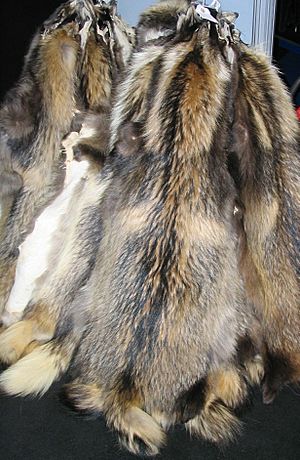
When used on clothing, the fur of the raccoon dog is often called "murmansky" or "tanuki" fur. In the United States, it is marketed as "Asiatic raccoon", and in Northern Europe as "Finn raccoon". Generally, the quality of the pelt is based on the silkiness of the fur, as its physical appeal depends upon the guard hairs being erect, which is only possible in silkier furs. Small raccoon dog pelts with silky fur command higher prices than large, coarse-furred ones. Due to their long and coarse guard hairs and their woolly fur fibre, which has a tendency to felt or mat, raccoon dog pelts are used almost exclusively for fur trimmings. Japanese raccoon dog pelts, though smaller than other geographic variants, are the most valued variety, with specimens from Amur and Heilongjiang coming close behind, while Korean and southern Chinese are the least valued. When raised in captivity, raccoon dogs can produce 100 g of wool of slightly lesser quality than that of goats.
In the Japanese islands, the natives employed raccoon dog skin to make bellows, to decorate their drums, and for winter headgear. Russian trade in raccoon dogs was quite developed in the Primorye and Ussuri areas in the 1880s. The world trade of raccoon dog pelts during 1907–1910 amounted to 260,000–300,000, of which an estimated 20,000 (5–8%) came from Russia, though more recent figures estimate a lesser number of 5,000–6,000; 12,000 raccoon dogs were caught in the 1930s. In their introduced range, licensed trade of raccoon dogs began in 1948–1950, with restrictions being removed in 1953–1955.
Folklore
In Japanese mythology, the raccoon dog or Tanuki, is known to be a shapeshifter, along with the fox, the badger, and other animals.
Images for kids
See also
 In Spanish: Nyctereutes para niños
In Spanish: Nyctereutes para niños



